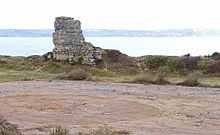Nicodemus Knob

Nicodemus Knob is a rough, lozenge-shaped 30-feet pillar left as a landmark quarrying relic at East Cliff on the Isle of Portland, Dorset, England. It is found close to the Verne High Angle Battery, Fancy's Family Farm (on site of ex-Portland Rotor Radar Station), the Young Offenders Institution and The Old Engine Shed, near East Weares and The Grove village. It is similar to the landmark quarrying pillar of Pulpit Rock, found at Portland Bill.[1]
History

The Nicodemus Knob stack was left standing after the surrounding area was quarried away to provide stone for the Verne Citadel and the Portland Breakwater - both major projects of the late 19th century. The limestone stack stands 10 metres high on East Cliff, close to the working Waycroft Quarry. It marks the extent to which the convicts excavated the stone from the Admiralties Quarries for use in the construction of the great government works. Some six million tonnes of stone was quarried from the area, most of it supplied by free labour of the convicts of the nearby Portland Prison.[2]
The reason for the stack being left is uncertain. Some theories state that it was a landmark for shipping, whilst other theories include it being a memorial to the quarry workers who moved so much material from the site, or that it was simply to highlight the large amount of stone taken from the area, recording the original natural ground level.[3] Other suggestions include the pillar was cut to mark the boundary of the eastern part of the common land/cliff-edge. The name was transposed from a promontory on the East Weares below the nearby Grove Point, anciently called 'Nicodemus Knowle', to which it was known until Victorian times.[4]
An amusing but fictional account appeared in the Free Portland News issue of June 1990. Geoff Kirby published his own theory of the stack's name:
| “ | An Irish Protestant named Nick O'Demus moved to Portland in about 1735. O'Demus was one of the few who took advantage of the local courting practices and in 1745, he had three 'fiancées' pregnant at the same time, who each lived on different parts of Portland. The local Court Leet discovered what was going on and took appropriate action. As a result, crude stories and jokes about O'Demus followed during the following two centuries when he became a cult figure. When the land was quarried at the top of the Incline Road to build the Verne Citadel a solitary pillar of rock was left by quarrymen as an appropriate monument to the legendary prowess of O'Demus. The Victorians later changed the name of Nick O'Demus's Knob to Nicodemus Knob with its religious and more laudable connotations. | ” |
Area
Close to the stack are flat rectangular areas which were once used at Royal Naval Dockyard's playing fields. After Portland Port Ltd acquired the land in the mid-1990s, it was used as an industrial storage site.[5] This was still in existence in 2006, but was later stripped and all storage removed. As of 2014, this site still remains entirely empty.[3]
In the 2010 book "Bird Observatories of Britain and Ireland", the area of Nicodemus Knob is noted to also have "a series of small walled fields", whilst the area is "botanically rich and often holds migrant birds".[6]
References
- ↑ Bob Ford, Nature Portfolio. "Nicodemus Knob by Bob Ford". Bobfordphotography.com. Retrieved 2012-11-24.
- ↑ "Quick facts about the Jurassic Coast". Jurassiccoastline.com. Retrieved 2012-11-24.
- ↑ 3.0 3.1 "Nicodemus Knob, Portland, Dorset". Geoffkirby.co.uk. Retrieved 2012-11-24.
- ↑ Legg, Rodney (1999). Portland Encyclopaedia. Dorset Publishing Company. p. 78. ISBN 978-0948699566.
- ↑ http://www.southampton.ac.uk/~imw/Portland-Quarries.htm
- ↑ Bird Observatories of Britain and Ireland - Mike Archer, Mark Grantham, Peter Howlett, Steven Stansfield - Google Books. Books.google.co.uk. Retrieved 2012-11-24.
Coordinates: 50°33′28″N 2°25′40″W / 50.5577°N 2.4278°W
| ||||||||||||||||||||||||||||||||||||||||||||||||||||||||||||||||||